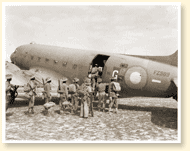

Troops boarding Douglas "Dakota" aircraft of No.435 Squadron, RCAF, Burma, December 23, 1944.
Photo : National Defence |
The Burma Campaigns, 1941-1945
Many Burmese, resenting Britain's hold over their country which went
all the way back to the nineteenth century, cooperated when the
Japanese invaded in December 1941. The Japanese saw Burma as a
stepping-stone to India as well as protection for their troops
fighting in the Malayan peninsula and in Singapore. At little cost,
by May 1942 they had driven the British Indian troops west into
India. The Japanese occupation of Burma cut the Burma Road from
Mandalay in north central Burma to China; the Americans had been
using that route to supply Chiang Kai-shek's Nationalist forces,
engaged in their own war against Japan ( see War in China, 1937-1945 ).
British attempts to get Burma back in 1942 and 1943 were
unsuccessful. The Japanese gave some independence to Burma in 1943,
but forced local workers, along with prisoners of war, to build the
Burma Railway. Over 100,000, a third of the labourers, died from
overwork, malnutrition and disease.
In March 1944, the Japanese tried to invade India from Burma,
through the hill tea plantations of Assam. British-led Indian troops held the Japanese at Kohima and Imphal for more than eighty
days, until the monsoon rains started. One third of the Japanese
force of nearly 85,000 died of disease, the greatest defeat of the
Japanese to that point of the war.
Toward the end of 1944, the British Fourteenth began the
offensive which led to the recapture of Rangoon in April 1945. Nos.
435 and 436 Squadrons, RCAF, flew their Dakota transport aircraft
on supply-dropping missions for the British , which was very
dependent on air support in an area with few roads. Many other Canadian
aircrew also served with
squadrons in southeast Asia.
Related Newspaper Articles
English Articles
- The Attack on Burma,
The Globe and Mail, 13/02/1942
- Lack of Aircraft and Men Among Reasons for Losses
The Hamilton Spectator, 04/05/1942
- New Japanese Drive into India is reported
The Globe and Mail, 24/03/1944
- Crash Kills Jungle Genius Orde Wingate
The Globe and Mail, 01/04/1944
- When the Rains Come Down in Burma
The Globe and Mail, 31/05/1944
- White Prisoners Worked to Death on Enemy Railway
The Hamilton Spectator, 19/12/1944
- Makes His Base In Shot-Up Craft
The Hamilton Spectator, 30/12/1944
- Canadian Draws Japs' Fire to Protect Supply Plane
The Hamilton Spectator, 03/02/1945
- Death of a Thousand Cuts Imposed on Japs by RAF
The Toronto Telegram, 07/04/1945
French Articles
-
Engagement anglo-japonais en Birmanie
Le Devoir, 17/01/1942
-
Birmanie. Les Japonais ont traversé la Salween
Le Devoir, 12/02/1942
-
La route brimane
Le Devoir, 14/02/1942
-
Offensive japonaise pour tenter de fermer la route de Birmanie
Le Devoir, 16/02/1942
-
Birmanie. Anglais et Indiens se replient vers le centre du pays
Le Devoir, 10/03/1942
-
Renforts en Birmanie
Le Devoir, 23/03/1942
-
Repli britannique en Birmanie
Le Devoir, 07/04/1942
-
Birmanie. Furieux engagements sur tout le front
Le Devoir, 16/04/1942
-
Birmanie. Des colonnes japonaises menacent de couper les principales lignes de communication alliés
Le Devoir, 28/04/1942
-
Brimanie. La chute de Lashio met en péril les armées anglaises et chinoises
Le Devoir, 30/04/1942
-
Birmanie. Des colonnes japonaises avancent vers l'Inde et Tchongking
Le Devoir, 04/05/1942
-
Autres attaques en Birmanie
Le Devoir, 22/05/1943
-
Un tiers de la Birmanie aux Alliés
Le Devoir, 05/09/1944
-
Vétéran de Birmanie
Le Devoir, 09/09/1944
-
Offensive britannique en Birmanie
Le Devoir, 12/09/1944
-
Gains en Birmanie
Le Devoir, 18/09/1944
-
Les fronts soudés en Birmanie du Nord
Le Devoir, 18/12/1944
-
L'ennemi se retire en Birmanie
Le Devoir, 23/12/1944
-
L'occupation de Rangoon est complétée
Le Devoir, 04/05/1945
-
La campagne de Birmanie est virtuellement terminée
Le Devoir, 11/05/1945
|